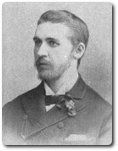Christina Rossetti, selected poems Contents
Early twentieth century approaches
Constrained by doctrine
.jpg) Many early twentieth century critics either dismissed Rossetti's poetry as too pious and depressing to merit sustained attention, or chose to read her writings in a purely biographical context. In 1919, Virginia Woolf voiced a popular opinion when she wrote in her diary that, in her attempt to make her ‘poetry subservient to the Christian doctrines', Rossetti:
Many early twentieth century critics either dismissed Rossetti's poetry as too pious and depressing to merit sustained attention, or chose to read her writings in a purely biographical context. In 1919, Virginia Woolf voiced a popular opinion when she wrote in her diary that, in her attempt to make her ‘poetry subservient to the Christian doctrines', Rossetti:
The phrase ‘austere emaciation' suggests severe and strict control. Claiming that Rossetti ‘starved' herself into this state indicates that she chose to forgo anything pleasurable. Whilst recognition of Rossetti's poetry as sober and morose draws attention to the renunciation it promotes, it often fails to take into account its concentration on reaching heaven. For more details about renunciation in Rossetti's writings see Poems for study > The Convent Threshold > Imagery, symbolism and themes > Renunciation.
Biographical interpretations
From the time of the poems' publication, attempts have been made to interpret Rossetti's poetry through biographical speculation.
 The first biography of Christina Rossetti's life was published by Mackenzie Bell in 1898, only four years after Rossetti's death. Entitled Christina Rossetti, a Biographical and Critical Study, this book considers Rossetti's writings in the context of her life. Having been acquainted with Rossetti herself, Bell writes of the ‘sombre tint' of the black dress that she wore and of the characteristics of her demure personality. His analysis of her poetry is very much intertwined with reflections on her own identity.
The first biography of Christina Rossetti's life was published by Mackenzie Bell in 1898, only four years after Rossetti's death. Entitled Christina Rossetti, a Biographical and Critical Study, this book considers Rossetti's writings in the context of her life. Having been acquainted with Rossetti herself, Bell writes of the ‘sombre tint' of the black dress that she wore and of the characteristics of her demure personality. His analysis of her poetry is very much intertwined with reflections on her own identity.
Later biographies of Rossetti have also largely relied on biographical speculation in an attempt to interpret some of the complexities of her poetry. For instance, in her 1963 biography of the poet, Lona Mosk Packer suggests that Rossetti's poems conceal a love for (already married) painter William Bell Scott. Added to this, in 1994, critic Jan Marsh published an extensive biography entitled Christina Rossetti: A Writer's Life. In this, she offers some good contextual information about Rossetti's family, her church and her relationships. However, in looking for the root cause of Rossetti's melancholy or depressive habits, she makes several unfounded assertions and speculations.
Close reading (‘new criticism')
The characteristic of detailed and pictorial representation that can be found throughout Rossetti's poetry can be described as Pre-Raphaelite. Very much influenced by the Pre-Raphaelite style of conveying meaning through symbolism, Rossetti's poetry contains features that are well suited to an interpretation by the process of close reading. For more information about the characteristics of Pre-Raphaelite art and poetry, see Literary context > The Pre-Raphaelite Brotherhood.
The close analysis of poetry was first promoted in the 1920s by the so-called ‘New Criticism' in the USA and by academics such as I.A.Richards, William Empson and F.R.Leavis in the English Department of Cambridge University in England.
The practice of close reading particularly focuses on:
- The ambiguities within texts
- Various layers of meaning or interpretation
- The paradoxes
- The undercurrents of tone
- The sincerity of the writer's voice
- The imagery used: how central it is to conveying meaning, how subtle its patterns, how symbolic, how original
- Skills with words, in wordplay, assonance, alliteration, puns
- Innovations with form, rhythm and other structures
- Evaluation in terms of the match or consonance of content, tone and expression
- Evaluating the overall merit of each text, in terms of the above.
For more information about the practice of close reading, see Critical approaches to literature > Close reading (‘new criticism').
Recently Viewed
Scan and go
Scan on your mobile for direct link.